The sweet potato, or Ipomoea batatas, is a member of the Convolvulaceae family of dicotyledonous plants, including bindweed and morning glory. As a root vegetable, it is prized for its vast, tuberous roots that are both starchy and delicious. Fresh young leaves and stems are a tasty addition to salads. Different colored flesh and skin can be harvested from different sweet potato cultivars.
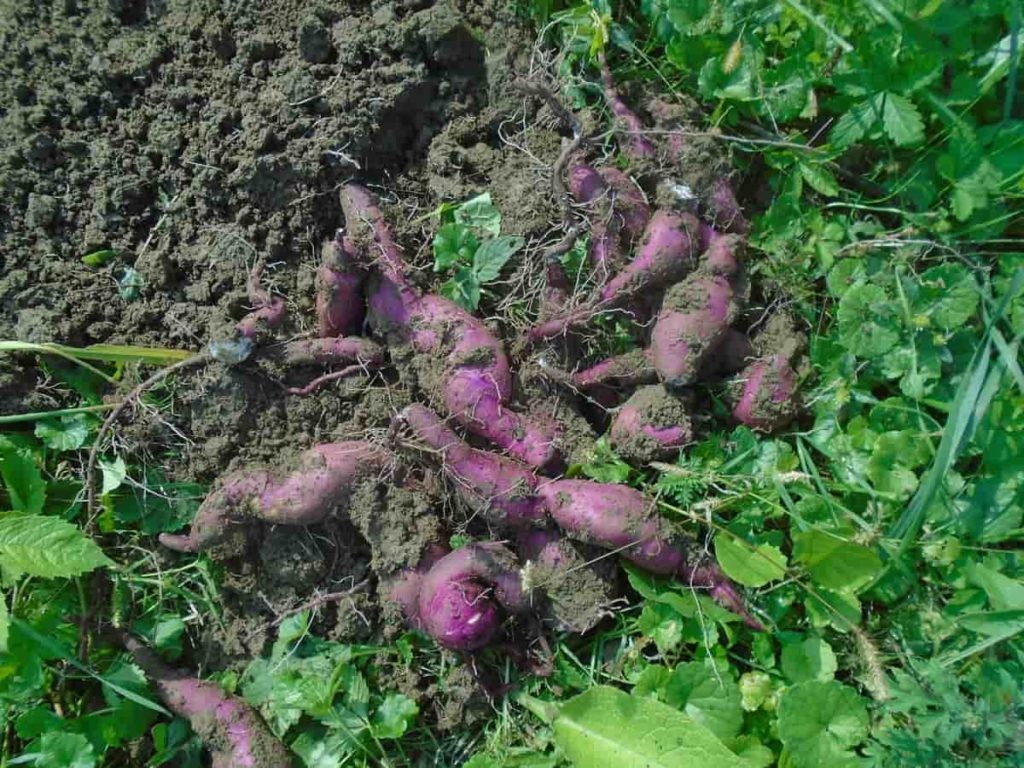
Although both the sweet potato and the common potato (Solanum tuberosum) are in the order Solanales, the two are only very closely related. The sweet potato plant dies if it gets too cold. Optimal conditions for growth include lots of sunshine and warmer evenings, with an average temperature of around 24°C (75°F). Annual average rainfall in the range of 750–1,000 mm (30–39 in) is optimal, with a minimum of 500 mm (20 in) throughout the growing season.
At the tuber initiation stage, which occurs 50–60 days after planting, the crop is vulnerable to drought. Likewise, water-logging is not tolerable, as it can lead to tuber rots and stunt the formation of storage roots if there isn’t enough air circulation. Depending on the cultivar and environmental factors, tuberous roots can be harvested anywhere from two to nine months after planting. Early-maturing cultivars can be cultivated as a summer annual with proper care in warm regions, such as the East Coast of the United States and parts of China.
When the length of a day is greater than 11 hours, as it typically is outside of the tropics, sweet potatoes rarely bloom. Stem cuttings, root cuttings, and “slips,” which are adventitious shoots that sprout from the plant’s tuberous roots while it is stored, are the most common regeneration methods. Only in breeding are true seeds used.
How to start Sweet Potato farming in Asia
Top sweet potato producing regions in Asia
Eighty percent of the world’s sweet potatoes come from China. Asia produces 86% of all sweet potatoes. India, Bangladesh, Vietnam, Indonesia, the Philippines, and other Pacific Island countries rely heavily on the sweet potato as a primary crop. Despite its importance as a nutritional source in South Asia, most of the region’s harvested sweet potato is used for either animal feed or industrial purposes.
China: Most of the world’s sweet potatoes are grown in China. Nearly 70% of the world’s total area under sweet potato production was located in China, wherein an estimated 6.6 million hectares were dedicated to the crop. About 84.4% of the world’s sweet potatoes were produced in China, producing around 100 million metric tons.
The Yellow and Yangtse River Basins are mostly where sweet potatoes are grown in China. Northern spring sweet potato region, Yellow River spring-summer sweet potato region, Yangtse River summer sweet potato region, Southern summer-fall sweet potato region, and Southern fall-winter sweet potato region are the five regions of sweet potato cultivation distinguished based on climatic conditions and the cropping system.
India: India’s sweet potato farms are expanding rapidly, both in size and output. It is estimated that roughly 115,000 hectares might be used for growing sweet potatoes in India in 2019–2020, and that yield per hectare will be 10.2 metric tons. Sweet potatoes are primarily grown in the Indian states of Bihar, West Bengal, Orissa, Uttar Pradesh, and Andhra Pradesh. Cultivation of the crop takes roughly 120 days, or four months, and produces an average of 10 to 12 tons per acre. The edible sections, the starchy roots, are the ones that are dug up and transported off to the market.
In case you missed it: How to Start Gardening at Home for Beginners: A Full Planting Guide for Flowers, Fruits, Herbs, and Vegetables
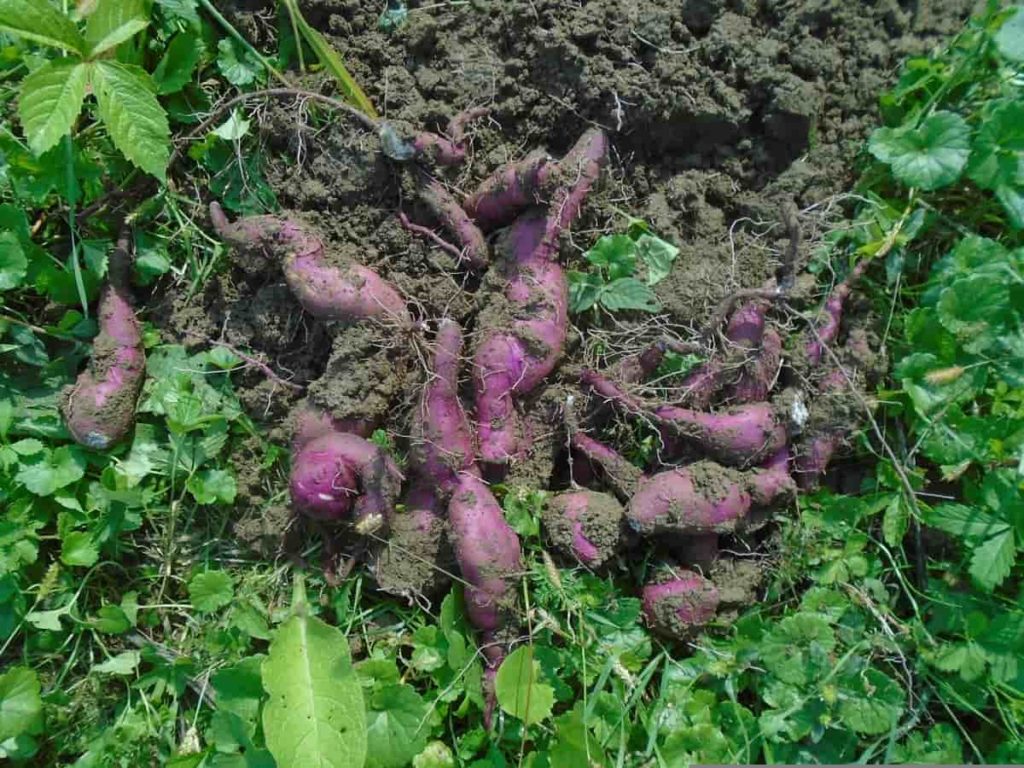
Bangladesh: Sweet potato farms in Bangladesh are mostly found along rivers and on islands in the water. About 6.5 million Bangladeshis, or about 4% of the total population, make their homes on the riverine islands (Char regions), where they face severe difficulties. About 0.13 million ha are dedicated to sweet potato farming in Bangladesh, yielding 1.47 million tons. The average production of orange flesh sweet potatoes at farm level in riverbanks and riverine islands is about 10-12 tons per hectare.
It is because orange flesh sweet potato types are typically less drought-resistant than white-fleshed cultivars. As a result, the potential yield can be as high as 35–40 tons per hectare, even though the crops require less irrigation and fewer inputs to flourish. Therefore, filling in the yield gap in these regions is a significant opportunity to boost sweet potato production.
Best season to grow sweet potatoes in Asia
The most significant times to grow sweet potatoes are in the warm, wet months of June, July, and September. It thrives in a roughly constant climate at 24°C (75°F), with lots of sunshine and mild evenings. The ideal amount of rainfall for a plant to thrive is between 750 and 1,000 mm (30 and 39 inches) each year, with at least 500 mm (20 inches) falling during the growing season.
The province of Shandong is one of China’s most important sources of sweet potatoes. The product can be shipped at any time of the year. However, the harvesting season is from August to October. Red-skinned, yellow-skinned, and even purple-skinned sweet potatoes are all cultivable.
When grown commercially, sweet potatoes can bring in large profits for low-income farmers in Bangladesh, improving their food security and economic situation. Between October and February, sweet potatoes are primarily grown in Bangladesh on the country’s peri-urban and peri-rural borders.
Varieties of sweet potatoes in Asia
Jewel sweet potato: Jewel sweet potatoes are visually similar to garnets and have the same deep orange, sweet flavor. Jewel sweet potatoes have copper-colored skin, slightly lighter than garnet sweet potatoes. One of the most well-liked orange sweet potato cultivars for use in baking and casseroles is the Jewel sweet potato.
Carolina ruby: One sweet potato variety developed from Beauregard’s sweet potato is the Carolina Ruby. The Carolina Ruby is recognized for its vivid orange meat under rich reddish-purple skin. The ruby skin that forms on this sweet potato variety after cooking is where the name comes from. Mildly sweet with deliciously moist flesh, Carolina Ruby sweet potatoes are highly praised for their flavor.
O’Henry: The O’Henry cultivar is a variety of sweet potatoes that should not be confused with ordinary potatoes. This sweet potato has a characteristic rectangular form with tapering ends; it evolved from Beauregard sweet potato. It has a pale tan exterior and a creamy white interior. The white flesh of the O’Henry sweet potato is almost as delicious as the orange flesh, which is why it is so widely consumed. The sweet, nutty flavor of the smooth flesh improves with baking, boiling, or frying.
Heirloom Sweet Potato: Root vegetables of long-established cultivars are known as “heirloom” kinds, and this is also the case with sweet potatoes. Heirloom sweet potatoes are favorites of home gardeners and are typically grown in smaller amounts. ‘Envy’ sweet potatoes are a typical kind of heirloom sweet potato.
The flesh of this heirloom sweet potato type is a pale orange tint, and its skin is a similar shade of orange. Cooked Envy sweet potatoes have a subtly sweet flavor and tender, juicy flesh. Sweet potatoes are versatile vegetables that can be roasted or added to stews.
Murasaki Japanese Sweet Potato: The Murasaki sweet potato, native to Japan, is among the unique Asian sweet potato kinds. It has a long thin form, a dark purple exterior, and a tender white interior. In contrast to most others, this Japanese sweet potato has drier flesh.
Germination process for sweet potato
Slips are immature shoots that can develop from mature sweet potato plants. Slips These can be purchased online or in a garden center, but they are also simple to cultivate in the comfort of your home. Find a sweet potato plant already fully grown and in good health, either at a nursery or in someone’s garden. Make sure the weather conditions are ideal. Tropical climates are ideal for the sweet potato’s development.
A good time to start your slips is in March or April. Put your slips in the ground in the spring, preferably in May or June. Place a couple of fresh sweet potatoes in the sink and thoroughly scrub them. The potato should then be sliced. You may want to try slicing the potato in half or even into thirds or fourths if it’s particularly large. Your slip-growing technique involves keeping your potato half submerged and a half above water.
Use a jar or glass cup with a large enough opening to contain your potato, then fill the vessel with water. Set up your potato with “spokes” by poking four or five toothpicks through its skin at intervals and close to its center. Put the sliced side of the potato into the jar/glass of water, then use the toothpicks to hold up the other half so that it rests on the rim of the container. To keep things organized, separate each potato slice into its jar. Place the glass jar with the potato in a corner where it will receive sufficient sunlight.
Keep an eye on the top of the potato for the next two to four weeks since this is when the little leafy slips will emerge. If the top of your potato is packed with slips, you can remove them by twisting them off one by one. They’ll seem like little leaves on a stem since they lack roots at this stage. Depending on how many slips you have, fill a shallow bowl with about an inch or so of water. Place the slips in the bowl, stem-side down, making sure the water covers it completely.
Let them grow like this for a few days or until roots begin to grow at the base. Slips need clean water once a day or such to survive. Toss the slips if you notice they aren’t growing roots or have started to die. After two or three days, the slips will have begun to root at the base. At this stage, you can bring your slips outside to plant them, and you can remove the water from the bowl. If you want to keep the roots from drying out, putting them straight into your garden or farm is better.
In case you missed it: Top 29 Vertical Vegetable Garden Ideas for Beginners: Check How this Guide Helps Home Gardeners
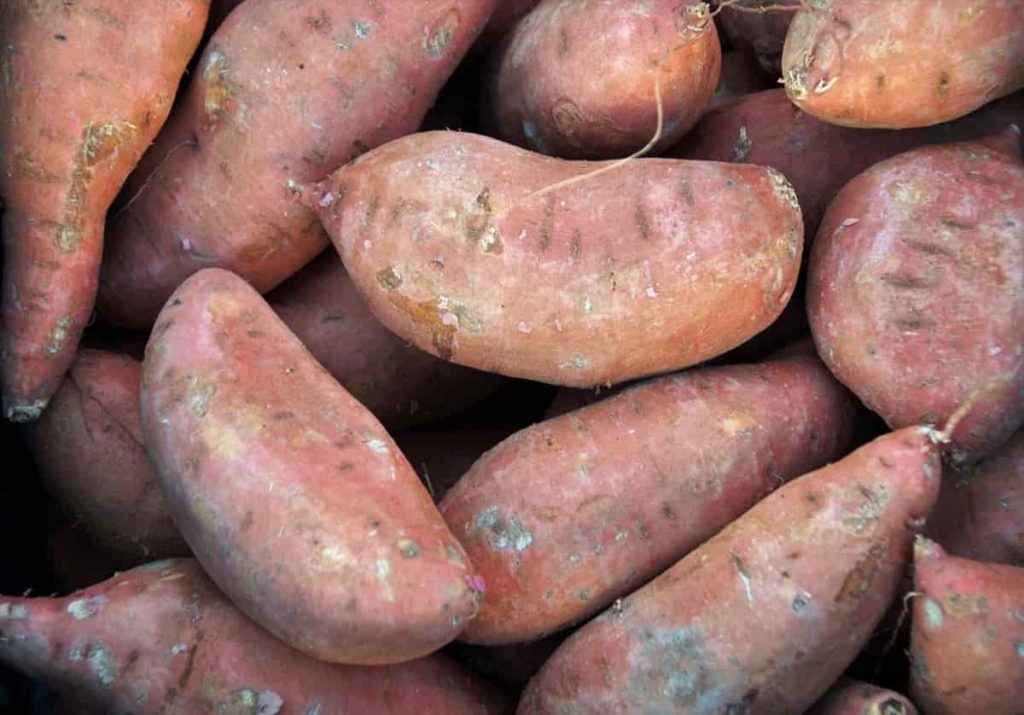
Soil preparation for sweet potato farming in Asia
Although most sweet potato plant grows underground, the vines are grown in the open. A single vine may reach a length of nearly ten feet. Check the size of your garden or farm to ensure enough space for the vines. If you want to grow sweet potatoes successfully, you should do it in a warm, sunny spot with good drainage (mainly if you live in the north). Given that they are tubers, sweet potatoes will develop underground. To make their job easier, till the soil to 12 inches (30.5 cm).
If necessary, add some gardening soil or loose dirt to the soil to make it as light and loose as possible. Mix in some high-quality compost or planting soil. Take out any huge rocks you find. Determine your soil’s pH level. Peat moss or wood ash can neutralize acidity or alkalinity if the pH is off. This process, known as “amending the soil,” is essential for plant growth. Learn when it’s best to put slips in the ground. Sweet potatoes are heat-loving and hence require warm soil to grow well. Plant your slips in the early spring, at least a month after the last frost.
Spacing
If you’re planting sweet potato slips in your garden, give them more room than usual by spacing them 12 to 24 inches apart. Only the root ball at the bottom of the slips and approximately half an inch up the plant’s base must be buried. Plant each small slip in its hole, ensuring the soil comes no more than half an inch up the stems. A potato plant’s leaves will spread outwards like vines as its roots grow 6 to 12 inches (15.2 to 30.5 cm) below the surface to form tubers.
Mulching
Adding mulch to your sweet potatoes will help keep them in heat and speed up their growth. After planting your potatoes, cover them with black plastic mulch or another heat-trapping material if you live in a particularly chilly area. A mulch of your choosing can keep the cold off your sweet potatoes. This will also aid in preventing the growth of weeds and vines, both of which compete with the tubers for resources.
Irrigation and water management
Give the plants some water. There will be an initial high water use when planting sweet potatoes. It would be best to gradually lower the frequency of watering until they get water once per week. First, you should start watering daily and gradually reduce your watering frequency as the week passes. After planting, sweet potatoes must be kept damp until their root systems have matured.
After that, it can withstand moderate drought stress for relatively short durations and bounce back fast once soil moisture is restored. A crop exposed to dry circumstances for an extended period will have its root development restricted and its photosynthetic capacity diminished, giving it an unhealthy appearance.
Sprinklers are the primary method of watering potatoes. The most prevalent types of systems are center pivot, wheel line, and solid sets. Sprinkler systems can efficiently distribute nutrients and some insecticides, making them more flexible than furrow irrigation systems. Sprinkler systems are the most efficient method for applying water evenly across a large area.
Sprinklers may be easily adjusted to work on uneven surfaces. Parameters in the potato canopy caused by sprinkler irrigation are favorable to spreading diseases such as early blight, late blight, bacterial stem rot, and white mold. Leave the plant material to dry out in between waterings to slow the spread of these diseases.
Fertilizer management
Potassium is essential for sweet potatoes, requiring between 150 and 200 pounds per acre compared to only 60 pounds of nitrogen and phosphorus per acre. Even though sweet potatoes don’t require a lot of nitrogen, it’s still essential to get the proportions right. Excessive nitrogen treatment promotes leaf growth without sufficient root development, reducing crop yield. Likewise, a lack of phosphorus can reduce growth, which reduces yield.
Your needs for these three vital plant nutrients will change depending on your sweet potato type. During the first 30 days, use 25 t/ha FYM (farmyard manure) along with 20:40:60 kg NPK/ha as a base. It is recommended that only two-thirds of the recommended Nitrogen dose be used if 20 kg/ha of Azospirillum is used. Applying Diammonium phosphate (DAP) as a source of nitrogen and phosphorus is recommended.
The land should be kept clean by hand weeding till vines are entirely established. About two weeks after sweet potatoes have been transplanted into the garden, you may begin fertilizing them. Afterward, you can fertilize them once every four to six weeks during the growing season. Applying fertilizer no more than thrice during the growing season is recommended.
Pest and disease management
Black rot: Black rot causes stunted growth, wilting, yellowing, leaf drop, plant death, and brownish-black circular spots of decay on tubers. Only disease-free seeds should be used, and fields previously used for sweet potato cultivation should wait at least three to four years before being replanted with the crop. Cuts made above ground are necessary to remove transplant material from the plant. Before planting seeds, a fungal treatment is recommended.
In case you missed it: Top 31 Vegetable Garden Ideas at Home: Check How this Guide Helps Beginners
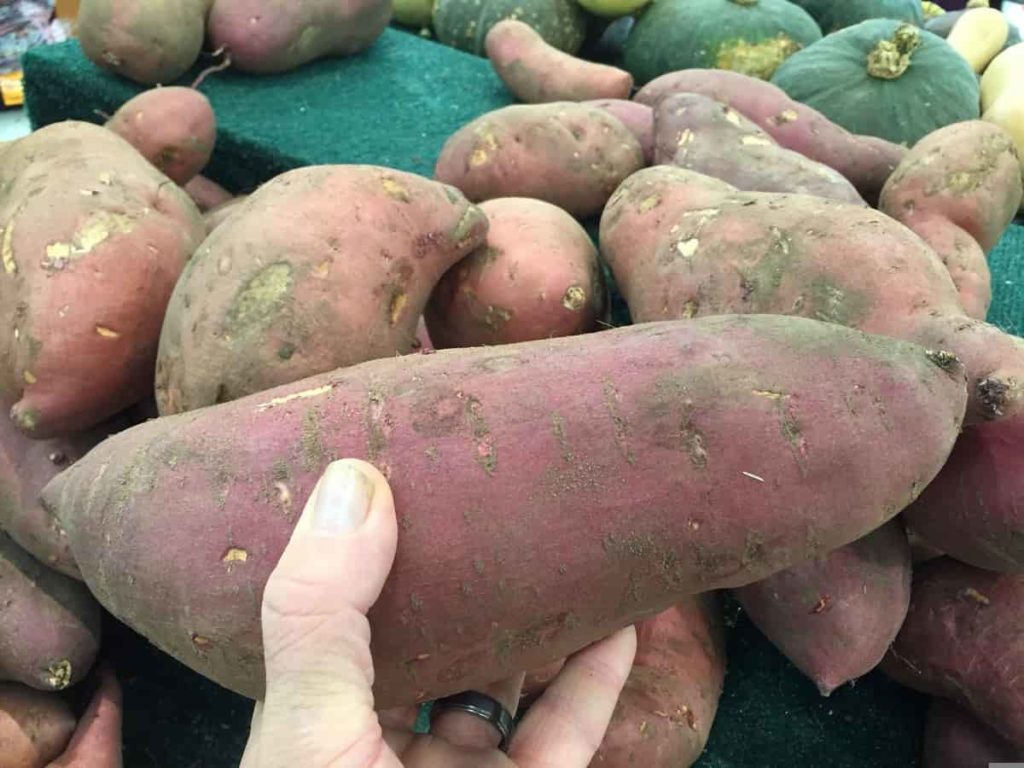
Bacterial soft rot: Bacterial soft rot manifests itself in several ways, including brown or black water-soaked tumors on stems and stalks, stem collapse, and areas of soft rot on storage roots that are initially colorless but eventually turn brown with a black margin. Avoid damaging storage roots at any time throughout their development, use only disease-free seeds, and remove and destroy any diseased stored roots. To prepare vines for transplantation, cut them above ground. It’s best to grow disease-proof sweet potato types.
Sweet Potato stem borer: Larvae make holes through the stem to reach the underground storage systems. The plant will wilt, become yellow, and eventually die if eaten in the crown. Holes in the stem and feces on the soil’s surface are clear indicators of borers.
Ipomoea species, among others, are particularly troublesome to have in a field, so make sure they’re pulled out often. The area should be left vacant for a few years if the infestation is severe. Make sure you choose plant material that is free of pests. Pheromone traps help monitor insect populations and reduce their numbers.
Harvesting
Because of their extended fruiting time, sweet potatoes are typically harvested in October. To maintain the plants healthy, keep watering them once a week and weeding the beds as needed. Approximately 120 days after planting, your sweet potatoes should be ready for harvest. The sweet potatoes will grow larger and have a better flavor if you wait as long as possible (until the last warm weather before a frost) to harvest them.
Curing sweet potatoes after they’ve been harvested is a crucial step. Curing will allow them to harden their skin and develop flavor (they won’t have much flavor right after being dug out). Maintain the sweet potatoes at a temperature of 85-95 degrees Fahrenheit (29-35 degrees Celsius) and a humidity level of 80-90% for 5-10 days. It should get them close to being ready for dinner.
The potatoes might be cured in a large closet or a small room with the help of a modest space heater and a humidifier. These delicious tubers have the added benefit of staying fresh and edible for months with appropriate storage. Keep the potatoes in an open, dry location at about 70 degrees (no refrigeration). Never use a plastic bag or other airtight containers when storing sweet potatoes.
Yield
Asia produces 125 million tons annually, making it the most significant producing region in the world. China produces 117 million tons or 90% of global sweet potato production. When compared, the annual production of sweet potatoes by African farmers is just about 7 million tons.
The average sweet potato yield in Asia is 18.5 tons per hectare, which is considerably greater. The most significant yields can be found in China (20.0 tons/ha), Japan (24.7 tons/ha), Korea (20.9), Thailand (12 tons/ha), and Israel (33.3 tons/ha).
In case you missed it: Texas Vegetable Planting Calendar (TX): Month Wise Chart, Zone 6, Zone 7, Zone 8, and Zone 9
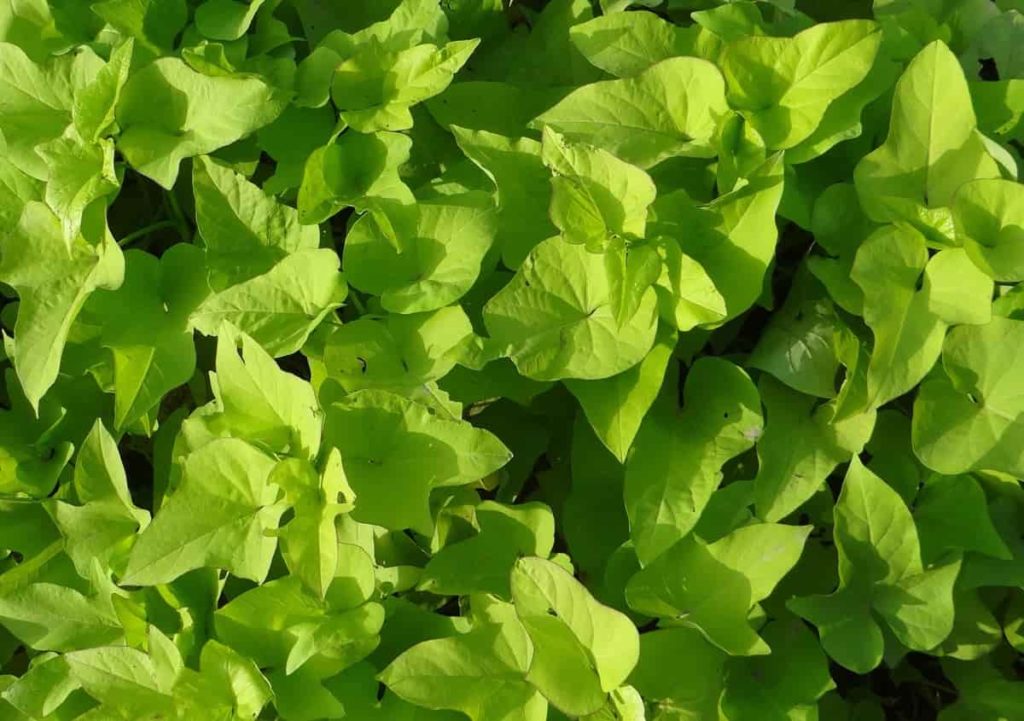
Most significant sweet potato production in the world
Sweet potato is widely grown and consumed in China, where it serves multiple purposes, including human and animal nutrition and industrial processing (as food, starch, and other products). China’s 6.6 million hectares of sweet potato fields are responsible for nearly 70% of the world’s total area dedicated to growing the sweet potato crop. As a result, China produced roughly 84.4 percent of the world’s 100 million metric tons of sweet potatoes in 2015.
Best place to grow sweet potatoes
Sweet potatoes require only average, well-drained soil and full sun to grow successfully. Planting sweet potatoes in rich, sandy potting soil in elevated beds is a good option if your soil is too dense or rocky. In extreme cold, the sweet potato plant will perish. Growing conditions are best when there is a lot of sunshine and warmer evenings, with an average temperature of about 24°C.
At least 500 mm of rain (20 inches) should fall during the growing season, and an annual average of 750 mm to 1000 mm (30 to 39 inches) is ideal. 50-60 days after planting is when the crop is most susceptible to drought, as this is when the tubers start to develop.
Growing sweet potatoes in the Philippines
In the Philippines, sweet potatoes (or “kamote” or “camote”) are becoming more popular as a healthy alternative to other staple foods. Because of its high carotenoid, calcium, phosphorus, vitamin A, and antioxidant content, many Filipinos choose it over the traditional poor man’s meal. In addition, iron and thiamine are also present in significant amounts in sweet potatoes.
One of the main reasons sweet potatoes became known as “poor man’s meal” is because they are so simple to cultivate. Minimal food and care requirements are all that are necessary. Furthermore, the tuber can be used for a wide variety of purposes. As a result, the Filipino people are beginning to see the potential of sweet potatoes as flour and animal feed sources.
Top sweet potato producing region in the Philippines
With a total of 49.69 metric tons produced, Bicol Region accounted for 30.3 percent of the Philippines’ total sweet potato production. Eastern Visayas came in second with 13.7%, and Central Luzon took third with 19.6%. The sweet potato harvest in the Philippines for April–June 2022 totaled 163.94 metric tons. Compared to the 157.68 kt produced during the previous year period, it represents a growth of 4.0%.
Conclusion
After rice, wheat, potatoes, maize, and cassava, sweet potato is the world’s sixth most significant food crop. In addition, it ranks as the world’s fifth-most-important food crop in developing nations. Worldwide annual production exceeds 105 million metric tons, with 95 percent coming from developing nations. It is possible to cultivate sweet potatoes everywhere, from sea level to an elevation of 2,500 meters.
In case you missed it: How to Start Eggplant/Brinjal Farming in Malaysia: Check How this Guide Helps to Grow Eggplant
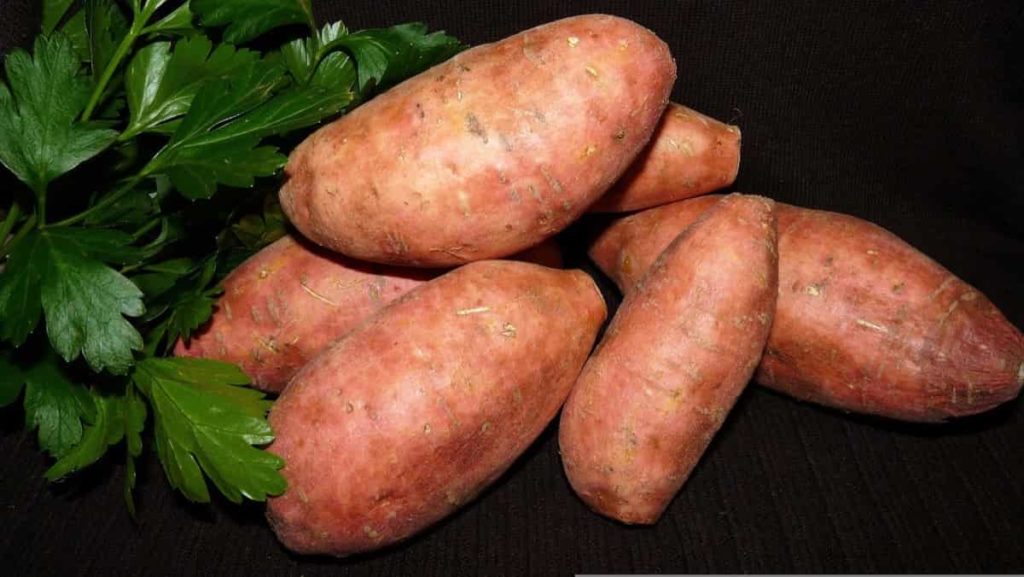
It grows well on poor soil and requires less water and effort than more popular crops like corn. Despite Asia’s booming economy, nearly 200 million people live on less than 1 US dollar daily. Knowledge of adapting small-scale farming systems to change is a critical tool for raising their incomes in the context of thriving growth and shifting markets. As a result, sweet potato is quickly becoming an increasingly vital food crop in several parts of Asia.
Its growth rate in South Asia is higher than other staple crops. Eighty percent of the world’s sweet potatoes are grown in China. Asia as a whole is responsible for 86% of global production. In addition to its prevalence in the Americas, the sweet potato is a significant cash crop in Asia, Oceania, and the Pacific. Despite its importance as a food staple in South Asia, most of the region’s harvested sweet potatoes are used as animal feed or processed into other products.
- Aquaponic Farming at Home: A Step-By-Step Guide
- Profitable Village Farming Business Ideas in 2024
- High-Yield Aquaculture: Fast-Growing Fish for Farming
- Effective Fish Pond Construction Techniques for Beginners
- Irrigation and Water Management in Pineapple Farming
- Blossom to Harvest: Mastering Flowering and Pollination in Papaya Farming
- Pig Fattening Essentials: From Selection to Sale for Beginners
- Raising Wagyu Cattle: A Complete Guide for Premium Beef Production
- Soil Types and Their Water Holding Capacity
- Optimizing Irrigation Schedules for Coconut Groves for Enhanced Yield
- Espresso Your Garden: Coffee Grounds for Healthier Acid-Loving Plants
- The Best Soil Mix for Snake Plants: How to Mix Your Own Snake Plant Soil
- Green Thumb Success: Expert Tips for Cultivating Greenhouse Beans All Year Round
- Bloom All Year Round: The Ultimate Guide to Indoor Hyacinth Care
- Eco-Friendly Gardening: How to Make Liquid Fertilizer from Kitchen Waste
- Ultimate Guide to Grow Anise in Pots: Explore Seed Propagation to Harvesting
- Guide to Raising Chester White Pigs: Discover Breed Facts to Growth Management
- Mastering the Elegance: The Ultimate Guide to Weeping Cherry Tree Care, Planting, and Maintenance
- Ultimate Guide to Planting Garlic in Grow Bags: Growing Strategies for Beginners
- How to Fix Spider Plant Leaf-Related Problems: Natural and Organic Remedies
- 10 Reasons Why Your Tulsi Plant is Shedding Leaves: Home Remedies and Solutions
- Optimizing Growth and Yield: The Advantages of Palm Bunch Ash Fertilizer
- Utilizing Neem Oil Extract as a Natural Pesticide for Hydrangea
- From Soil to Harvest: Various Ways in Which Farmers Can Use AI Tools
- Steps to Encourage and Induce Citrus Flowers: A Comprehensive Guide
- How to Fix Snake Plant Leaf-Related Issues: Natural and Organic Remedies
- Transform Your Garden into a Fragrant Oasis with Raat Ki Rani (Night Blooming Jasmine)
- Discover the Ideal Chicken Breeds for Philippine Farms
- How to Create a Poultry Egg Farm Business Plan for Profits
- Grow Lemon Cucumbers Like a Pro: Insider Techniques for Bountiful Yields
- Ultimate Guide to Caring for Your Pink Princess Philodendron: Tips for Thriving Variegation
- Areca Nut Profit Per Acre: Calculating Yield and Cost of Cultivation
- How Kaveri Chicken is Becoming a More Profitable Breed in Indian Backyards
- Transform Your Barn: 9 Steps to Convert a Horse Stall into a Chicken Coop
- Exploring Suffolk Sheep Disadvantages with Limitations and Challenges
- Guide to Solving Potted Lemon Tree Problems: How to Revive Lemon Tree in Containers
